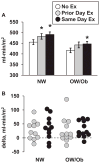A single exercise session increases insulin sensitivity in normal weight and overweight/obese adolescents
- PMID: 29687558
- PMCID: PMC6201285
- DOI: 10.1111/pedi.12684
A single exercise session increases insulin sensitivity in normal weight and overweight/obese adolescents
Abstract
We measured the effect of an aerobic exercise session on postprandial glucose control in adolescents with habitually low-physical activity. The goal was to determine if the acute or residual response of exercise was altered in people who are overweight/obese (OW/Ob). Eleven normal weight, body mass index (NW, BMI = 48 ± 13 percentile) and 12 OW/Ob (BMI = 91 ± 5 percentile) participants completed 3 trials. In the no exercise (No Ex) trial, participants rested quietly before and after consuming a test meal. In the other 2 trials, a 45-minute aerobic exercise session was performed either 17-hour (Prior Day Ex) or 40 minutes (Same Day Ex) before the test meal. On all trials, the OW/Ob group had higher fasting glucose (~6%) and insulin (~66%), and lower insulin sensitivity (~9%) than the NW group. The Same Day Ex and Prior Day Ex trials resulted in reduced area under the curve for glucose (6% on both trials, P < .01) and insulin (15% and 13%, respectively, P < .03), and increased insulin sensitivity (8% and 6%, respectively, P < .01). The magnitudes of those effects did not differ between the NW and OW/Ob groups. Plasma fatty acids declined and carbohydrate oxidation increased after the meal, but did not differ among trials or groups. The results demonstrate that moderate intensity aerobic exercise increases insulin sensitivity in NW and OW/Ob adolescents and that the beneficial effects of exercise last up to 17 hours. The acute impact of exercise on metabolic health in adolescents is not impaired in overweight/obese participants.
Keywords: glucose tolerance; mixed meal; physical activity.
© 2018 John Wiley & Sons A/S. Published by John Wiley & Sons Ltd.
Figures




References
-
- Aucouturier J, Duché P, Timmons BW. Metabolic flexibility and obesity in children and youth. Obesity Reviews. 2011;12:e44–e53. - PubMed
-
- Twig G, Tirosh A, Leiba A, Levine H, Ben-Ami Shor D, Derazne E, et al. BMI at age 17 years and diabetes mortality in midlife: A nationwide cohort of 2.3 million adolescents. Diabetes Care. 2016;39:1996–2003. - PubMed
-
- Shaibi GQ, Cruz ML, Ball GD, Weigensberg MJ, Salem GJ, Crespo NC, et al. Effects of resistance training on insulin sensitivity in overweight Latino adolescent males. Med Sci Sports Exerc. 2006;38:1208. - PubMed
-
- Bell LM, Watts K, Siafarikas A, Thompson A, Ratnam N, Bulsara M, et al. Exercise alone reduces insulin resistance in obese children independently of changes in body composition. J Clin Endocrinol Metab. 2007;92:4230–5. - PubMed
Grants and funding
LinkOut - more resources
Full Text Sources
Other Literature Sources
Miscellaneous

